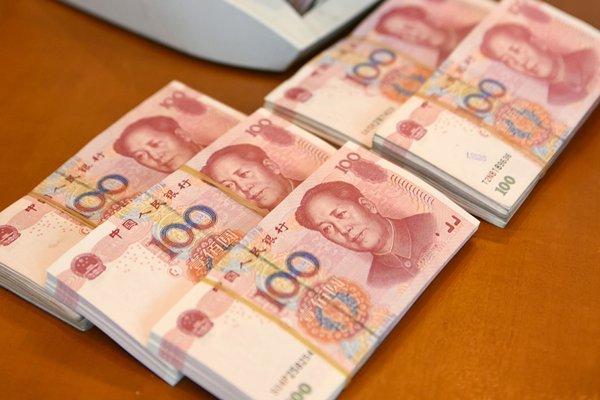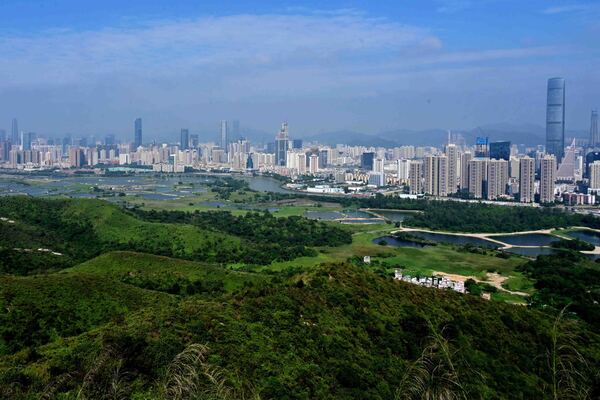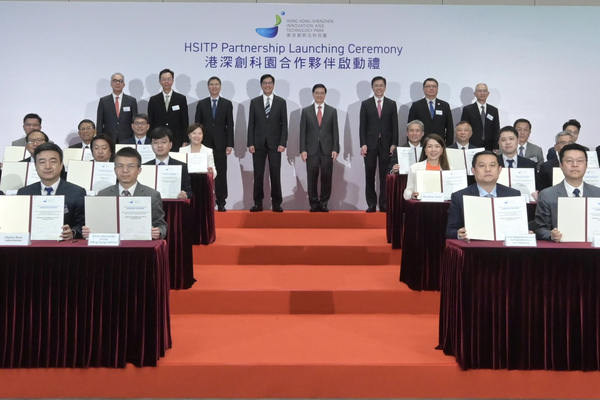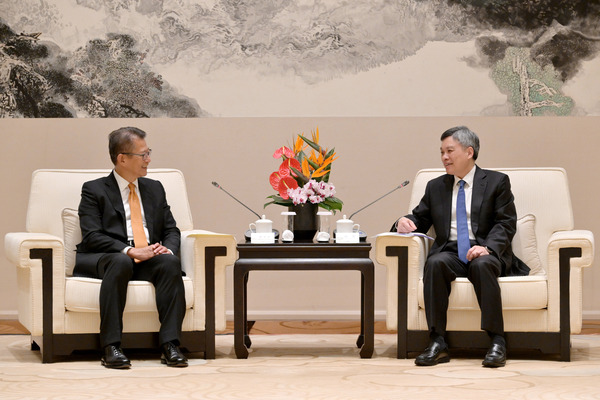E-CNY BEING ACTIVELY STUDIED
11-1-2022
Alphabetical Index
依字母搜索

Economic and social development will power Hong Kong's fortunes this year, and for many years to come. This has been made possible thanks to, first and foremost, the major breakthrough in our local political development in the last two years.
To begin with, we secured the implementation of the National Security Law in Hong Kong in 2020, which has since restored order and stability to our society and our economy. Then came the enhancements to our electoral system, under which two elections have recently been successfully concluded, putting an end to the previous chaos and political impasse in Hong Kong.
Together, these developments not only cemented the foundation of “one country, two systems” and provided maximum safeguards for Hong Kong to harness the strengths under the arrangement, but also reshaped the landscape of good and effective governance and propelled Hong Kong into a new development phase, where we can focus on the future - on building a flourishing economy, and a more cohesive community, for our city.
On the national front, in the face of the continuing China-US tension, the 14th Five-Year Plan for national economic and social development advocates a new development strategy of dual circulation, whereby domestic circulation as the mainstay would be supported by external circulation, with the domestic and external markets reinforcing each other. Leveraging our unique advantages under “one country, two systems”, Hong Kong has much to contribute to and benefit from this dual circulation strategy.
Also driving Hong Kong forward is the recent initiative to deal with two fundamental issues that have long constrained our economic and social development, namely economic diversification as well as land and housing shortage.
The development of the Northern Metropolis as announced in the Policy Address last year would provide practical answers to these problems. The visionary development strategy entails dual-core planning, whereby financial services, our most competitive sector, will continue to develop from its current stronghold, ie the Harbour Metropolis in the southern part of our city. Meanwhile, our new engine for economic development, ie innovation and technology, will be positioned at the Northern Metropolis.
This development blueprint will provide Hong Kong with the much needed solution spaces. It will not only guide the development of related infrastructure, facilities and supporting services to build a convenient, liveable and green community for our people, but also broaden the foundation of our economy by fostering the development of the innovation and technology sector. On a broader and deeper level, the blueprint maps out enhanced intercity co-operation with our neighbouring cities in the Guangdong-Hong Kong-Macao Greater Bay Area, particularly Shenzhen, a leader in the tech sector with strengths complementary to that of Hong Kong. The Northern Metropolis will be the key powerhouse for this synergistic collaboration.
We indeed have much to work with. Hong Kong is the only city in the world to offer a secure, dynamic and prosperous environment for business and direct access to the Mainland market.
The National 14th Five-Year Plan also sets out the long-range objectives of the country through the year 2035, and strategically affirms the role and positioning of Hong Kong in the overall development of our country, presenting opportunities in various areas of importance. Of all the specific roles of Hong Kong, the support of which has been reaffirmed or established, the one of particular relevance to us on this occasion is Hong Kong's continued expansion as an international financial centre, encompassing the strengthening of our status as a global offshore renminbi business hub as well as an international asset-management and risk-management centre.
While a lot of developments on this front have already been covered in the remarks of the Chief Executive yesterday, I intend to give more colour to three key areas which are worth elaboration.
First, the tremendous opportunities for Hong Kong's financial market arising from the Mainland's continuing development.
Thanks to the support of the central government, Hong Kong remains the world's biggest offshore renminbi business hub and renminbi clearance, product and fund centre. We also run the world's largest offshore renminbi foreign exchange and interest-rate derivatives market and enjoy a leading position in renminbi settlement, financing and asset management.
Looking forward, we will take forward a number of initiatives to develop an even more vibrant offshore renminbi ecosystem in Hong Kong, including further building up the offshore renminbi liquidity pool, increasing the utilisation of the renminbi in various forms, encompassing renminbi bonds, loans, equities and other securities products, as well as strengthening our Central Moneymarkets Unit and developing it into an international central securities depository in the long run.
Opportunities also flow from the mutual market access between the Mainland and Hong Kong. In the past few years, various connect schemes have been launched successively, including Stock Connect, Bond Connect and the mutual recognition of funds between the Mainland and Hong Kong. With the inclusion of renminbi-denominated assets in major international financial market indices, the average trading volume of the Stock Connect transactions last year reached about RMB120 billion a day, an increase of 32% over the previous year. On the other hand, the number of Mainland bonds held by overseas institutions through the northbound connect and other channels of Bond Connect exceeded RMB3.9 trillion by end of 2021.
And we will continue with our effort to widen and deepen this mutual market access. As you know, southbound trading under the Bond Connect was launched in September. It expands the connect family's product offerings, allowing onshore investors to diversify their asset allocation. It also creates enormous opportunities for Hong Kong's financial sector, enhancing our attractiveness as a bond-issuing centre, while boosting the internationalisation of the renminbi.
Meanwhile, with the promise of mutual market access programmes, investor demand for risk-management tools is also on the rise. Our stock exchange responded in October last year, launching the MSCI China A 50 Connect Index futures contract. Formally approved by the Mainland, the contract is an offshore, A-share index futures product. The market response has been phenomenal, with the average daily trading volume hitting more than 19,000 contracts in December, five times the size of that in October. The product should serve as a valuable risk-management tool for offshore investors, while diversifying Hong Kong's financial product offerings.
The mutual market access has been brought to another level with the launch of Wealth Management Connect in the bay area in October. Targetting individual investors, the scheme creates huge opportunities for our financial and professional services sectors and has been well received to date. We are working closely with relevant authorities to ensure its smooth operation, while considering further expanding the depth and width of the scheme.
Before I move on, I should complete the picture by mentioning the much anticipated return of the China concept stocks. With Mainland companies seeking to grow still hoping to explore international financing, yet in the face of increasing regulatory uncertainty in the US, it is likely that we would see more China concept stocks return from the overseas market. We are actively making preparations for that, including the recent enhancements to our secondary listing regime, both in terms of lowering the listing threshold and relaxing the qualifications restrictions, which would boost our competitiveness in attracting more of such stocks to get listed in Hong Kong.
The second key area to highlight here is our continuous effort and determination to further develop our financial market.
Building a diversified, vibrant and sustainable fundraising platform with a view to elevating the platform's overall competitiveness has always been our focus. Other than implementing a new listing regime for special purpose acquisition companies and the enhancement of the secondary listing regime just mentioned, we have also been actively seeking to promote the further development of our bond market.
To this end, I have led a steering group comprising financial regulators and market experts to drive effort on this front. Drawing from their collective wisdom, the group had come up with strategies and initiatives, which would certainly help us chart a rewarding way forward.
Worth mentioning here is that while the various debt issuances have the main objective of promoting the bond market thereby benefitting the financial industry, we have always kept in mind the importance of also having the general public share the fruit of such market developments. The issuance of our inflation-linked retail bonds and Silver Bonds last year were vivid examples of this. On the horizon is the issuance of our first-ever retail green bonds, which will not only provide an avenue for the public to invest but also raise public awareness of green finance as well as promote green economy.
Another important area we are eyeing which has been gaining steam around the world is infrastructure financing. Seizing the opportunities offered by significant developments in the region, the Hong Kong Monetary Authority (HKMA) already established back in 2016 the Infrastructure Financing Facilitation Office to act as a useful platform for facilitating infrastructure investment and their financing. The effort was complemented in 2019 by the setting up of an infrastructure financing and securitisation business, which is given the mandate to purchase and co-finance infrastructure loans and securitise them after accumulating a diversified portfolio. Within a short time frame, we have made significant progress in acquiring and warehousing many infrastructure loan assets, across various sectors and geographies, paving the way for the launch of their securitisation. This would help mobilise market liquidity into an attractive alternative asset class and at the same time help fill market gaps in infrastructure financing.
The third key area which is central to Hong Kong's financial services future is the development of financial technology, or fintech.
Our central bank equivalent, HKMA, announced the Fintech 2025 strategy in June, one strategic direction under which is to strengthen research work on central bank digital currency (CBDC) with a view to future-proofing Hong Kong in terms of its readiness in this area. Apart from the continued and expanded collaborative effort with peer central banks on cross-border application of wholesale CBDC, the HKMA has started a study on the prospect of issuing retail CBDC in Hong Kong.
In the meantime, the HKMA and the Digital Currency Institute of the People's Bank of China are actively testing the use of digital renminbi for cross-boundary payments. The results, to date, are encouraging. The next phase of technical testing includes expanding the participation of Hong Kong banks and topping up the digital renminbi wallet via our Faster Payment System.
I am hopeful that the digital renminbi, or e-CNY, will offer an additional means of safe, convenient and innovative cross-boundary retail payment for residents in Hong Kong and the Mainland, while promoting the interconnectedness of the bay area.
The HKMA and the People's Bank of China also signed an MOU (memorandum of understanding) in October linking the bank's Fintech Innovation Regulatory Facility with the HKMA's Fintech Supervisory Sandbox. The network initiative may allow financial institutions and technology companies to conduct fintech trials in Hong Kong and other bay area cities, expediting the launch of fintech products and lowering development costs.
Already, 10 banks in Hong Kong have expressed interest in the network and its cross-boundary fintech initiatives. About half are focused on Wealth Management Connect opportunities.
Before I close, I should also briefly highlight a promising development in regard of our effort in investing into the future. An investment portfolio named Hong Kong Growth Portfolio (HKGP) was set up last year for making strategic investments in projects with a Hong Kong nexus, with a view to reinforcing Hong Kong's status as a financial, commercial and innovation centre and raising Hong Kong's productivity and competitiveness in the long run, while seeking reasonable risk-adjusted returns. All mandates for the strategic investment have been successfully allocated to a total of eight general partners, which have diverse experience in investing in a wide spectrum of industries. We look forward to the support of HKGP for worthwhile local projects to the long-term benefit of Hong Kong.
The above are just some examples of how Hong Kong is consolidating our strengths as an international financial centre, capitalising on our ever-deepening ties with the Mainland. The end result will, I am confident, create mutually rewarding relations between the Mainland and Hong Kong and, through Hong Kong, the world at large.
Financial Secretary Paul Chan delivered this video speech at the 15th Asian Financial Forum held online on January 11.
PREVIOUSNEXT
Latest Business News
最新商業資訊
Chinese culture festival set 18-4-2024

The inaugural Chinese Culture Festival (CCF) will be held from June to September, presenting various performing ar...
FS tours Hangzhou, Suzhou 18-4-2024
Financial Secretary Paul Chan today met Communist Party of China (CPC) officials and visited research and development (R&...
I&T park's partners help attract talent 18-4-2024

I am delighted to be here with you today, for the Partnership Launching Ceremony of the Hong Kong-Shenzhen Innovation &am...
I&T park signs partnership pacts 18-4-2024

The Hong Kong-Shenzhen Innovation & Technology Park Limited (HSITPL) today signed memoranda of understanding (MOUs) w...
